Wyoming New Hires: Examining the Wage Gap
The Wyoming New Hires Survey, combined with Research & Planning's driver's license records, makes it possible to examine wage disparity in Wyoming at the occupational level. Among new hires in fourth quarter 2009 and first quarter 2010, females earned an average hourly wage of $10.25, compared to $14.00 for males. The difference in pay can be attributed to the different types of jobs that are available to males and females.
Regardless of economic conditions, Wyoming employers hire new workers. From fourth quarter 2008 to fourth quarter 2009 – when Wyoming first entered into an economic downturn – the state's total employment decreased from 287,478 to 269,439 (-6.3%). Then,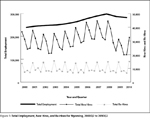 from first quarter 2009 to first quarter 2010, employment again decreased from 273,471 to 260,726 (-4.7%). However, even though employment was shrinking, employers hired new workers (see Figure 1). This article will specifically look at fourth quarter 2009 and first quarter 2010, when Wyoming employers added 39,902 new hires. A new hire is defined as someone who has never worked for that employer before.
from first quarter 2009 to first quarter 2010, employment again decreased from 273,471 to 260,726 (-4.7%). However, even though employment was shrinking, employers hired new workers (see Figure 1). This article will specifically look at fourth quarter 2009 and first quarter 2010, when Wyoming employers added 39,902 new hires. A new hire is defined as someone who has never worked for that employer before.
In 2010, the Research & Planning (R&P) section of the Wyoming Department of Employment began collecting data on jobs for which workers were recently hired through a New Hires Survey (Knapp, 2011). Employers were asked to provide detailed information on the characteristics of jobs for which workers were hired, such as wages, benefits offered, hours worked, and whether the worker was still employed one quarter later (the cover letter and questionnaire that were mailed to employers can be found online at http://doe.state.wy.us/LMI/energy/new_hires_survey.pdf).
Linking this survey information to R&P's driver's license data to obtain demographics makes it possible to compare wages for male and female new hires. Wage disparity in Wyoming – the difference in wages earned by males and females – is a topic that has been extensively studied by R&P (Jones, 2007 and 2008). Prior to this New Hires Survey, however, information on wage disparity was only available at the industry level. This survey makes it possible to directly compare the earnings of males and females in the same occupation, and also examine the percentage of new workers offered select benefits, hours worked, and worker retention, or how many new hires were still retained one quarter later.
Note that this article examines median hourly wages rather than using mean wages. The median hourly wage is the middle point of all of the data collected, meaning that half of the new hires were above this wage and half were below. With smaller samples, a single extreme value can make the mean problematic. The median does not suffer this limitation.
Wage Disparity: Rate of Compensation
Among new hires in fourth quarter 2009 and first quarter 2010 in all occupations, the average hourly wage paid for jobs worked by males was $14.00, while the average hourly wage for jobs worked by females was  $10.25 (see Table 1). The age distribution was very similar for male and female new hires across all occupations. For example, workers age 35-44 accounted for 18.5% of all male new hires and 17.4% of all female new hires, respectively. Note that age and gender data were not available for an estimated 6,109 new hires. These were people who did not possess a Wyoming driver's license, and most likely were workers from out of state (Jones, 2004). Future research will help identify characteristics of these workers and examine what role they play in Wyoming's economy.
$10.25 (see Table 1). The age distribution was very similar for male and female new hires across all occupations. For example, workers age 35-44 accounted for 18.5% of all male new hires and 17.4% of all female new hires, respectively. Note that age and gender data were not available for an estimated 6,109 new hires. These were people who did not possess a Wyoming driver's license, and most likely were workers from out of state (Jones, 2004). Future research will help identify characteristics of these workers and examine what role they play in Wyoming's economy.
The data collected from the New Hires Survey indicate that the gender wage gap among Wyoming workers is due in large part to a difference in opportunity structure. Wyoming's economy is driven largely by the natural 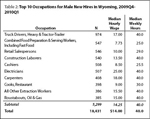 resources & mining and construction industries. Occupations within these industries tend to be high-paying jobs that have traditionally been held by males. This can be seen among new hires during this period (see Table 2). The most prominent occupation for male new hires during this period was truck drivers, heavy & tractor-trailer; there were an estimated 974 males hired to fill this occupation, paid a median hourly wage of $17.00. Other prominent occupations for male new hires included electricians (507 new hires, $25.00 average hourly wage), carpenters (408, $18.00), all other extraction workers (386, $15.50), and roustabouts, oil & gas (385, $15.00).
resources & mining and construction industries. Occupations within these industries tend to be high-paying jobs that have traditionally been held by males. This can be seen among new hires during this period (see Table 2). The most prominent occupation for male new hires during this period was truck drivers, heavy & tractor-trailer; there were an estimated 974 males hired to fill this occupation, paid a median hourly wage of $17.00. Other prominent occupations for male new hires included electricians (507 new hires, $25.00 average hourly wage), carpenters (408, $18.00), all other extraction workers (386, $15.50), and roustabouts, oil & gas (385, $15.00).
By comparison, female new hires employed during this period were hired 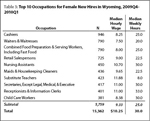 to fill low-paying jobs (see Table 3). Among the estimated 15,362 female new hires, 946 were hired as cashiers, earning a median hourly wage of $8.25. Females also were frequently hired as waiters & waitresses (790 new hires, $7.50 hourly wage), combined food preparation & serving workers, including fast food (790, $8.00), and retail salespersons (725, $9.00).
to fill low-paying jobs (see Table 3). Among the estimated 15,362 female new hires, 946 were hired as cashiers, earning a median hourly wage of $8.25. Females also were frequently hired as waiters & waitresses (790 new hires, $7.50 hourly wage), combined food preparation & serving workers, including fast food (790, $8.00), and retail salespersons (725, $9.00).
Males and females who were hired to fill the same occupations during this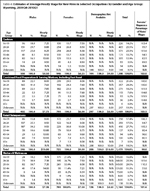 period generally earned similar wages (see Table 4). For example, the estimated 508 male new hires employed as cashiers earned a median hourly wage of $8.50, while the estimated 946 females in the same occupation earned $8.25.
period generally earned similar wages (see Table 4). For example, the estimated 508 male new hires employed as cashiers earned a median hourly wage of $8.50, while the estimated 946 females in the same occupation earned $8.25.
This was true among several occupations with high numbers of both male and female employees. Males hired as combined food preparation & serving workers, including fast food, earned $7.73 per hour, compared to $8.00 for females. Females hired as retail salespersons earned $9.00 per hour, compared to $10.00 per hour for males, while males hired as waiters & waitresses earned $7.38 per hour compared to $7.50 per hour for females.
Wage Disparity: Hours Worked
The number of hours worked by new hires has a greater influence on the wage disparity in Wyoming than the actual rate of pay. Across all 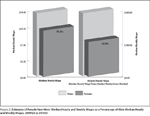 occupations, female new hires worked an average of 30 hours per week, while males worked 40. On an hourly basis, the median hourly wage for female new hires was 73.2% of male new hires earnings (see Figure 2). However, multiplying the median number of hours worked by the median hourly wage for all occupations shows that female new hires earned just 54.9% of male new hires on a weekly basis, since they worked fewer hours than males and earned a lower hourly wage.
occupations, female new hires worked an average of 30 hours per week, while males worked 40. On an hourly basis, the median hourly wage for female new hires was 73.2% of male new hires earnings (see Figure 2). However, multiplying the median number of hours worked by the median hourly wage for all occupations shows that female new hires earned just 54.9% of male new hires on a weekly basis, since they worked fewer hours than males and earned a lower hourly wage.
Females hired to work in lower-paying occupations typically were offered fewer hours per week (see Table 3). Females who were hired to work as waiters & waitresses – the lowest-paying occupation ($7.50 per hour) among the top 10 occupations with the highest number of female new hires – worked 20 hours per week. By comparison, females who worked in higher-paying occupations worked more hours; females hired as receptionists & information clerks earned $11.00 per hour and worked an estimated average of 33 hours per week.
Male new hires in higher-paying occupations were more likely to work more hours (see Table 2). Truck drivers ($17.00 per hour), electricians ($25.00), and carpenters ($18.00) all worked 40 hours per week. Among the top 10 occupations with the highest number of male new hires, 6 worked 40 hours per week.
Males and females who were hired to fill the same occupations worked 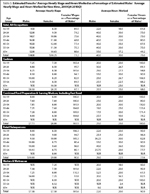 very similar hours (see Table 5). For example, males and females hired as combined food preparation & serving workers, including fast food, both worked 25 hours per week. Males hired as cashiers worked 25.5 hours per week, while females hired for the same occupation worked 25; this is not considered a statistically significant difference.
very similar hours (see Table 5). For example, males and females hired as combined food preparation & serving workers, including fast food, both worked 25 hours per week. Males hired as cashiers worked 25.5 hours per week, while females hired for the same occupation worked 25; this is not considered a statistically significant difference.
Males were more likely to be hired for occupations that offered benefits, such as paid time off, health insurance, and retirement (see Figure 3). The gap was especially wide for health insurance benefits; 37.5% of male new hires were offered health insurance, compared to 26.3% of female new hires. 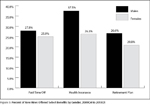 Access to benefits is highly associated with full-time and part-time status (Leonard, D., and Knapp, L., 2011). Full-time workers are more likely to be offered access to benefits than part-time workers. For example, in 2009, an estimated 80.2% of full-time workers in Wyoming were offered access to health care, compared to 19.8% of part-time workers.
Access to benefits is highly associated with full-time and part-time status (Leonard, D., and Knapp, L., 2011). Full-time workers are more likely to be offered access to benefits than part-time workers. For example, in 2009, an estimated 80.2% of full-time workers in Wyoming were offered access to health care, compared to 19.8% of part-time workers.
Conclusion
The wage gap in Wyoming is due in large part to the types of occupations available to males and females as measured by the New Hires Survey. Males are typically hired for jobs in expansion-related industries like natural resources & mining and construction and receive comparatively higher pay than males in other areas of the country. Females are hired for occupations that pay less and offer fewer hours. Benefits such as health care, retirement, and paid time off are more likely to be offered to full-time employees.
Four panels of data for four quarters have been collected through the New Hires Survey. The data presented in this article are from fourth quarter 2009 and first quarter 2010, the lowest point of Wyoming's economic downturn. The next two panels of data will be comprised of considerably more new hires; future articles will be included in Wyoming Labor Force Trends, and updates to the data can be found online at http://doe.state.wy.us/LMI/energy.htm.
Associate Editor Michael Moore can be reached at (307) 473-3814 or michael.moore@wyo.gov.
References
Jones, S. (2004). Worker residency determination — Wyoming stepwise procedure. Wyoming Labor Force Trends, 41 (8). Retrieved May 3, 2011, from http://doe.state.wy.us/LMI/0804/a1supp.htm
Jones, S. (2007). Demographic effects of Wyoming's energy-related expansions. Wyoming Labor Force Trends, 44 (4). Retrieved April 19, 2011, from http://doe.state.wy.us/LMI/0407/a1.htm
Jones, S. (2008). Examining the wage gap in Wyoming's counties. Wyoming Labor Force Trends, 45 (8). Retrieved April 19, 2011, from http://wydoe.state.wy.us/LMI/0808/a1.htm
Knapp, L. (2011). Survey captures data on Wyoming new hires. Wyoming Labor Force Trends, 48 (2). Retrieved April 13, 2011, from http://doe.state.wy.us/LMI/0211/a2.htm
Knapp, L., and Leonard, D. (2011). Wyoming Benefits Survey 2010. Retrieved April 20, 2011, from http://www.doe.state.wy.us/LMI/benefits2010/benefits_2010.pdf
